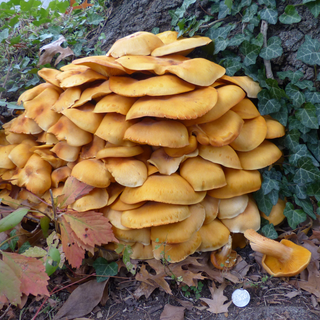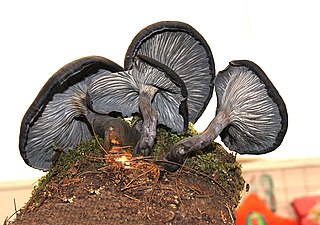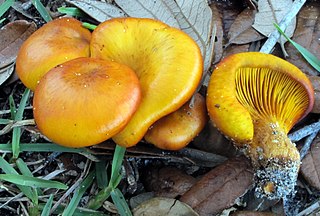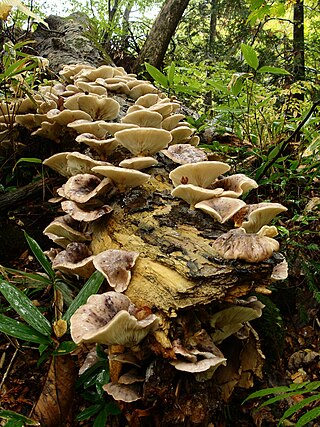
Cantharellus is a genus of mushrooms, commonly known as chanterelles, a name which can also refer to the type species, Cantharellus cibarius. They are mycorrhizal fungi, meaning they form symbiotic associations with plants. Chanterelles may resemble a number of other species, some of which are poisonous.

Omphalotus olearius, commonly known as the jack-o'-lantern mushroom, is a poisonous orange gilled mushroom that to an untrained eye appears similar to some chanterelles. It is notable for its bioluminescent properties. It is found in woodland areas in Europe, where it grows on decaying stumps, on buried roots or at the base of hardwood trees. It has also been reported from the Western Cape Province, South Africa. A similar, but phylogenetically distinct species found in eastern North America is Omphalotus illudens.

Mushroom poisoning is poisoning resulting from the ingestion of mushrooms that contain toxic substances. Symptoms can vary from slight gastrointestinal discomfort to death in about 10 days. Mushroom toxins are secondary metabolites produced by the fungus.

Omphalotus illudens, commonly known as the eastern jack-o'lantern mushroom, is a large, orange mushroom that is often found in clumps on decaying stumps, buried roots, or at the base of hardwood trees in eastern North America. Its gills often exhibit a weak green bioluminescence when fresh. This green glow has been mentioned in several journal articles, which state that the phenomenon can persist up to 40–50 hours after the mushroom has been picked. It is believed that this display serves to attract insects to the mushroom's gills during nighttime, which can then distribute its spores across a wider area.
The illudins are a family of sesquiterpenes with antitumor antibiotic properties produced by some mushrooms. In their isolated form, illudins show selective toxicity for myelocytic leukemia and other carcinoma cells.

Clitocybe is a genus of mushrooms characterized by white, off-white, buff, cream, pink, or light-yellow spores, gills running down the stem, and pale white to brown or lilac coloration. They are primarily saprotrophic, decomposing forest ground litter. There are estimated to be around 300 species in the widespread genus.

Pleurotus is a genus of gilled mushrooms which includes one of the most widely eaten mushrooms, P. ostreatus. Species of Pleurotus may be called oyster, abalone, or tree mushrooms, and are some of the most commonly cultivated edible mushrooms in the world. Pleurotus fungi have also been used in mycoremediation of pollutants, such as petroleum and polycyclic aromatic hydrocarbons.

Hygrophoropsis aurantiaca, commonly known as the false chanterelle, is a species of fungus in the family Hygrophoropsidaceae. It is found across several continents, growing in woodland and heathland, and sometimes on woodchips used in gardening and landscaping. Fruit bodies (mushrooms) are yellow–orange, with a funnel-shaped cap up to 8 cm across that has a felt-like surface. The thin, often forked gills on the underside of the cap run partway down the length of the otherwise smooth stipe. Reports on the mushroom's edibility vary – it is considered poisonous, but has historically been eaten in parts of Europe and the Americas.

Omphalotus nidiformis, or ghost fungus, is a gilled basidiomycete mushroom most notable for its bioluminescent properties. It is known to be found primarily in southern Australia and Tasmania, but was reported from India in 2012 and 2018. The fan or funnel shaped fruit bodies are up to 30 cm (12 in) across, with cream-coloured caps overlain with shades of orange, brown, purple, or bluish-black. The white or cream gills run down the length of the stipe, which is up to 8 cm (3 in) long and tapers in thickness to the base. The fungus is both saprotrophic and parasitic, and its fruit bodies are generally found growing in overlapping clusters on a wide variety of dead or dying trees.
Victor Fayod was a Swiss mycologist, who created an influential novel classification of the agaric fungi and who described a number of new genera and species.
Jack o' lantern mushroom is a common name for several fungus species in the genus Omphalotus:

Omphalotus olivascens, commonly known as the western jack-o'-lantern mushroom, is an orange to brown-colored gilled poisonous mushroom endemic to the California Floristic Province. It is sometimes mistaken for chanterelles.
Neonothopanus gardneri, locally known as flor de coco, is a bioluminescent fungus native to Goiás, Piauí and Tocantins states in Brazil.

Omphalotus mexicanus is a gilled basidiomycete mushroom in the family Marasmiaceae. Found in Mexico, it was described as new to science in 1984. Fruit bodies contain the toxic compounds illudin S and illudin M.

Omphalotus subilludens, commonly known as the Southern Jack O'lantern mushroom, is a basidiomycete fungi in the genus Omphalotus. It has been definitively recorded in Florida and Texas with reports of species in Arizona and Mexico. It fruits on dead and dying trees during warmer parts of the year, producing a fairly large orange to brown-orange fruiting body that occurs in clusters. It is most closely related to O. olivascans, O. olearius, and O. japonicus and has high cross compatibility with O. olivescans and O. olearis. It is poisonous to humans and animals when eaten but rarely produces life-threatening symptoms, usually poisonings are resolved in 24-48 hours, with the majority of symptoms being gastrointestinal. Compounds in these mushrooms have pharmacological potential with potential applications in anti-coagulants, cancer therapies, and antibiotics. It is also bioluminescent producing a faint glow around the gills through the oxidation of luciferase.

Omphalotus japonicus, commonly known as the tsukiyotake(月夜茸), is an orange to brown-colored gilled mushroom native to Japan and Eastern Asia. It is a member of the cosmopolitan genus Omphalotus, the members of which have bioluminescent fruit bodies which glow in darkness. A 2004 molecular study shows it to be most closely related to a clade composed of Omphalotus nidiformis of Australia, Omphalotus olivascens of Western North America and Omphalotus olearius of Europe.
Omphalotus flagelliformis is a bioluminescent fungus native to Yunnan Province in southwestern China. Fruitbodies are reddish-brown to brown, with convex, flattened, or funnel-shaped caps typically 4–8 cm (1.6–3.1 in) in diameter. Described as new to science in 2013, the type collection was found the year previous in Kunming Botanical Garden at an elevation of 1,980 metres (6,500 ft). It was fruiting in a cluster around the base of a tree identified as being in the family Fagaceae. Molecular analysis suggests that Omphalotus flagelliformis is closely related to O. illudens and O. mexicanus. The specific epithet flagelliformis refers to the "flagelliform" appendages of the cheilocystidia.
The following outline is provided as an overview of and topical guide to fungi and mycology:

Hypsizygus ulmarius, also known as the elm oyster mushroom, and less commonly as the elm leech, elm Pleurotus, is an edible fungus. It has often been confused with oyster mushrooms in the Pleurotus genus but can be differentiated easily as the gills are either not decurrent or not deeply decurrent. While not quite as common as true oyster mushrooms, they have a wide range globally in temperate forests. The mushrooms and vegetative hyphae of this species have been studied in recent years for their potential benefits to human health, and mycoremediation.




















